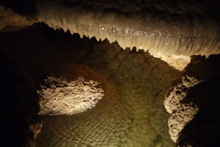Article
A sedimentary rock composed primarily of calcium carbonate, colloquially known as calcite. Limestone can form in two ways: the first occurs when organic remains, such as coral and shell, accumulate as particulate debris on the ocean floor over time. The second method is the chemical precipitation of calcium carbonate, which is when calcium carbonate that may be dissolved in a watery landscapes precipitates, or is removed, from its marine solution to settle onto the ocean floor. The water in which limestone forms is often warm and calm, so that the organic remains or chemical depositions are able to accumulate undisturbed over time, ultimately compressing themselves into layers of limestone under their own weight. As the earth ages, limestone environments that were formerly under water become exposed as prehistoric bodies of water recede. Some of the most extraordinary limestone deposits can also be found underground in caves, like those found throughout the Southwestern United States.
"Limestone deposits via evaporation and deposition in Carlsbad Caverns, New Mexico, November 18, 2010" by benson42 is licensed under CC BY.
Manuscripts
A05 Listening Woman (02-13) p. 41
A05 Listening Woman (02-13) p. 76
A05 Listening Woman (02-13) p. 180
A05 Listening Woman (02-13) p. 189
A05 Listening Woman (02-13) p. 190
A05 Listening Woman (02-13) p. 191
A05 Listening Woman (02-13) p. 192
A05 Listening Woman (02-13) p. 196
A05 Listening Woman (02-13) p. 197
A05 Listening Woman (02-13) p. 198
A05 Listening Woman (02-13) p. 210
A05 Listening Woman (02-13) p. 220
A05 Listening Woman (02-13) p. 227
References
King, Hobart
2014. "Limestone: What is Limestone and How Is it Used?" Geology.com.
http://geology.com/rocks/limestone.shtml, accessed June 23, 2014.

